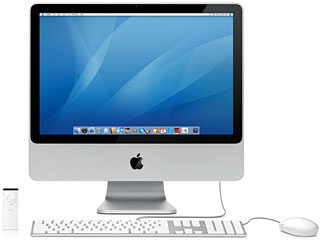There are frankly crazy rumors going about that Apple is ready to launch MacBooks, Mac minis, and perhaps even iMacs with up to four 4-core ARM-based CPUs. The next generation iPhone/iPad CPU will almost certainly be a 4-core 64-bit Apple chip named the A8. But in Macs?
I’ve looked at this subject before, until now seeing it as about two years ahead. But not this time. I think we are on the verge of seeing real Macs based on ARM processors.
 What’s changed? The iPad Air has a Geekbench 3 multicore score of 2499 for its 1.4 GHz dual-core A7 CPU, which puts it on par with a 2.4 GHz MacBook with a Core 2 Duo CPU, which was the top-end MacBook in 2007. That’s still a far cry from the slowest i5-based Mac, a 1.6 GHz 11″ MacBook Air from 2011 that scores 50% higher. But we’re in the ballpark.
What’s changed? The iPad Air has a Geekbench 3 multicore score of 2499 for its 1.4 GHz dual-core A7 CPU, which puts it on par with a 2.4 GHz MacBook with a Core 2 Duo CPU, which was the top-end MacBook in 2007. That’s still a far cry from the slowest i5-based Mac, a 1.6 GHz 11″ MacBook Air from 2011 that scores 50% higher. But we’re in the ballpark.
I’m writing this on a 2.0 GHz Core 2 DuoLate 2008 Aluminum MacBook, and my newest desktop is a 2.0 GHz Core 2 Duo 2007 Mac mini. These have sufficient power for my needs, but the iPad Air has 25% more horsepower than either of them.
How Apple Could Do It
Apple could run it A7 ARM chips faster than on the iPhone and iPad, where it runs at a slower speed to reduce battery consumption and heat. If Apple were to use a 2 GHz A7 CPU, it would have nearly 50% more processing power than the 2.4 MHz MacBook we’ve been comparing. It would be very close to that 1.6 GHz i5-based MacBook Air. And that’s going to be plenty of power for most users.
Or Apple could use a new CPU, perhaps a 4-core A8 CPU, which at 1.4 GHz would nearly double performance over today’s 2-core A7. So a Geekbench score in the 5000 realm. Not bad at all! That’s roughly equivalent to the 2.4 GHz Core i5 13″ MacBook Pro from 2011. If you’re a regular Low End Mac reader, that may well be more power than your current Mac offers.
 Now boost that from 1.4 GHz to 2.0 GHz, and we’re in the 7000 to 7500 range – equivalent to a 4-core i5-based 2011 iMac running at 2.5 GHz. Now that’s some serious horsepower!
Now boost that from 1.4 GHz to 2.0 GHz, and we’re in the 7000 to 7500 range – equivalent to a 4-core i5-based 2011 iMac running at 2.5 GHz. Now that’s some serious horsepower!
What Apple Probably Won’t Do
While I find that reasonable for entry-level Macs, I can’t see Apple installing two or more CPUs. Sure, they may have prototypes like that, but four separate 4-core CPUs fighting for data is just going to be a messy situation – not to mention an expensive one. There could be some dual-A8 machines, but in low-end Macs, that’s going to provide all the power you need.
The x86 Catch
Were Apple to introduce ARM-based Macs, it would have the same issue it had when moving from Motorola 680×0 to PowerPC and later from PowerPC to Intel, but with one additional hitch. The proposed A8 CPU is less powerful than anything Apple is using today, so emulating an x86 Mac would result in a drop in performance. With PowerPC and Intel, the new CPUs were very powerful, so emulating didn’t result in a performance hit.
The other x86 advantage is the ability to virtualize Windows and Linux in parallel to OS X. That would disappear on ARM Macs – although Linux could be compiled for the A8 and Windows already has an ARM version of Windows 8.1 for its low-end Surface tablets. Still, you’d lose full speed access to existing x86 software.
The App Store
Count on the Mac App Store being the primary – if not only – source for software for ARM-based Macs. It’s something Apple has been moving toward on Intel Macs but can never pull off because there are so many other sources of Mac software.
Another benefit of migrating Macs to ARM is that they could emulate iOS devices, so you could run the iPhone or iPad version of your favorite apps alongside Mac software. Not only would that be very cool, but it would provide an ideal platform for iOS developers.
If Not Now, When?
Realistically, Apple could do it now. The ARM processor is powerful enough. That said, there’s no software, and nobody is going to be happy only running Apple branded software and iOS apps on their MacBook or desktop Mac. It’s going to take a while to recompile and optimize software for the new hardware.
My guess is that Apple will first make development systems available, which they could announce at WWDC 2014. This will allow developers to work with the new hardware and test ports of their applications to it. Then in early 2015, maybe we’ll see consumer Macs built around Apple’s own CPUs.
No promises, but it seems a likely scenario.
Then again, Microsoft’s ARM-based Surface tablets have not been the success Microsoft expected, so expect Apple to tread cautiously.
Keywords: #armmacs
Short link: http://goo.gl/hHcff2
searchword: armmacs


I don’t think it will ever happen. Apple pulling together their own x86 design? Now that I CAN believe.
I don’t think they would do it in the desktop machines, though. Not the Mac Pro, that’s for damn sure. The Air might be the only one.
I think it is a long shot they will. Losing Intel would mean losing running Windows programs at full speeds. On the other hand, Apple made the transition from PPC to Intel. Maybe there is another Rosetta type program in the fold that can translate Intel to Apple CPUs on the fly. Still think the general public would have a hard time with this. Then again, maybe an iOS emulator for the Mac OS. Hmm?
I believe it’ll happen, and Apple is laying the groundwork for it.
1. Swift. What’s the purpose of having yet another programming language? Is it just to make writing programs for iOS/ OSX quicker and easier, or is it to lay the groundwork to quickly switch processors?
2. Processor speed diminishing returns. Just how “fast” can a processor get, and how can Apple advertise that speed? For example, if a computer’s startup time goes from 10 seconds to 5 seconds, is that really a speed increase that can be advertised? I think not.
3. Apple does not like relying on others for parts, especially if there’s a sole supplier, like Intel. Apple is building their own displays for the iOS devices, building their own chips, and basically building their own fabs for the laptop displays. Intel is the only company that makes chips that are cool enough and fast enough for their desktops.
4. Windows is not a big selling point for Macintoshes. Sure, some people buy Macs just to wipe the hard drive and install Windows, but those people are few and far between. Besides, you could run Windows on a Mac using SoftPC starting from 1992 (and potentially earlier). I’m sure there’ll be X86 emulators for any Apple processor that’s fast enough. In fact, on my late 2009 Mac Mini, Windows XP is fast enough in VMWare for Adobe CS2, and Microsoft Office 2007 where I can use it without slowdowns.
5. The biggest marketing point for laptop computers is how long the battery lasts. If Apple designs a CPU, they can optimize it for OSX, and make it as energy efficient as possible. Apple could be the only computer with a laptop that lasts for 24 hours on a single charge.
6. Apple seems to change processor families every 11 years. They used a CISC processor (68xxx series) from 1984 – 1995, and used a RISC Power PC processor from 1995 – 2006. Expect them to use a x64 processor from 2006 – 2017. Remember, back in 2002 eWeek leaked a rumor saying OSX was running on an Intel platform (see http://www.eweek.com/c/a/Apple/Apple-Keeps-x86-Torch-Lit-with-Marklar/). And it ended up being true. And there are rumors about OSX on an Apple processor now; and I think it’s true.
I’m not expecting Apple to release a new Apple desktop processor any time soon, but expect to hear about it at WWDC 2016.
ARM is unlikely to keep a significant power advantage over Intel’s Atom in the long run, as both are aiming for the same spot with low-end Atom’s and high end ARM cores. It’s likely that in the not too distant future that both will be roughly equal with regards to performance and power consumption, taking away the primary reason for interest in ARM CPUs.
There aren’t any parallels here to Apple’s previous CPU switches: 68K was a dead-end, keeping up with Intel & AMD proved too expensive for IBM and Motorola, but switching from x86 to ARM would provide a slower, less compatible platform instead of the perfectly healthy x64 platform. Intel are still the leaders on performance vs power consumption for CPUs, not ARM.